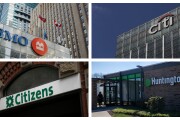
The nation's eight largest banks will all increase their dividends following affirmation from the Federal Reserve that they would have plenty of capital to power through a worst-case economic scenario.
The announcements come on the heels of the Wednesday release of the
The tests, which modeled a severe global recession with high unemployment and a real estate crisis, found that banks could see losses of nearly $685 billion.
The annual stress tests results guide the Fed in setting banks' so-called stress capital buffers, which are added on top of a common equity tier 1 capital ratio of 4.5% to calculate minimum capital requirements. Some of the largest banks — including
In practice, minimum
Roughly half of the 31 banks that were stress-tested this year released statements after the stock market closed on Friday about their preliminary stress capital buffers. Nine of those companies said that their preliminary stress capital buffer is larger than last year's, while the buffer was smaller at four banks, and it was unchanged at three more.
The Fed is expected to finalize the final stress capital buffers for the stress-tested banks by Aug. 31.
What the big banks said
Goldman Sachs reported one of the biggest increases in its stress capital buffer, as that number rose from 5.5% last year to 6.4%.
"This increase does not seem to reflect the strategic evolution of our business and the continuous progress we've made to reduce our stress loss intensity, which the Federal Reserve had recognized in the last three tests," Chairman and CEO David Solomon said in a press release. "We will engage with our regulator to better understand their determinations."
The new stress capital buffers at all of the affected banks will be effective from Oct. 1, 2024, through Sept. 30 of next year.
Among the four U.S. megabanks, only
Under Fraser, the New York-based bank, which has far-flung operations, is working on a massive, multiyear restructuring that involves selling or winding down lagging businesses and eliminating 20,000 jobs, or about 10% of its total workforce, by the end of 2026.
"The board's intended dividend increase, our second this year, would represent a sustainable level of capital distribution to our shareholders, which is supported by our strong financial performance and continuous investments in our business," Chairman and CEO Jamie Dimon said in a prepared statement.
He added that the share repurchase program, which could total $30 billion, provides "additional flexibility to return excess capital to our shareholders over time, as and when appropriate."
The outlook for regional banks
Among the 16 banks that released information about their stress capital buffers on Friday, Truist Financial is one of the four whose buffer will decrease. The $535 billion-asset company said its preliminary buffer — 2.9%, down from 2.8% currently — does not include the impact of the recent sale of its insurance arm or a balance sheet repositioning that took place in early May.
Truist plans to keep its common stock dividend flat, but the Charlotte, North Carolina-based company also announced that its board of directors has authorized a $5 billion share repurchase program through 2026 that will commence during the third quarter of this year. In April, Truist
CEO John Woods said in a statement that the Fed's test modeled a decline in pre-provision net revenue, a common profit metric in the industry, that was much worse than what
Also on Friday, Cincinnati, Ohio-based Fifth Third announced that it plans to recommend a two-cent per share increase to its quarterly cash dividend on its common stock in September, "consistent with its planned capital actions submitted to the Federal Reserve."
Fifth Third's stress capital buffer ticked up from 2.5% to 3.2%, but the $214.5 billion-asset bank noted that its CET1 ratio of 10.5% is well above its required minimum, which as of last year was 7%.






